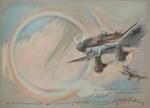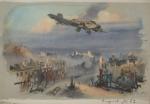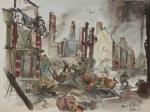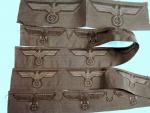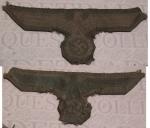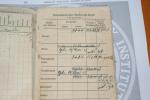-
Posts
1,869 -
Joined
-
Last visited
-
Days Won
7
Content Type
Profiles
Forums
Blogs
Gallery
Events
Store
Everything posted by Spasm
-
EBJ Sounds like you've got that figured about right, I've read similar, let me go look..... "Since 19 May 1936, by the order of Huhnlein, all scabbards were painted black or alternatively replaced......Being too expensive for a standard SA member (price of 7.05RM) scabbards of the early daggers were treated with black paint or replaced by privately purchased SS scabbards" - The Service Daggers of the SA and the NSKK. And as there were no Gruppe marks after 1936 it looks like your guy had an issued SA within Gr P and later joined the NSKK at which point he replaced his scabbard as it was cheaper than buying a whole new dagger. I also expect the scabbards were pretty easy to come by at that time, probably a NSKK guy supplying black painted ones as a swap for the original brown one to keep costs down. Spaz
-
EBJ The Franken dagger I own and the one shown in Ralf's book are both stamped 15. But as far as I am aware there was no Brigade 15 in Franken. The only Brigade 15 I am aware of (and I have very limited knowledge on Brigades) was based in Itzehoe which is in your Nordmark Gruppe. However, there was a Standarte 15 in Franken (as well as in other Gruppe) but alongside the Fr stamp the dagger can be identified to the correct one. Are you sure about the Pommern dagger? As far as I am aware Pommern was only an SA marking. Could your guy have initially been SA and transferred to the NSKK painting his scabbard black? Which would fit with a later Brigade as the Gruppe mark wouldn't have been there after 1936. Spaz
-
EBJ Thanks for your post. The ID you have with different dagger and Ausweis numbers seems to blow that theory then (along with the one that is in Ralf Seigert's book). The daggers were simply numbered on the dagger and the scabbard (as K98 bayonets were) at the 'depot' and that number entered into the Ausweis when the dagger was issued. Same as a Soldbuch that has equipment numbers inside - you wouldn't expect a luger number to match the bloke it was issued to. By the way, it would be nice to see your daggers Cheers Spaz
-
That's all sorted then. Just need to make a nice handle.
-
How great is that - even she said it was very impressive. Blimey, a good comment from her indoors about militaria! Outstanding. Do you have any others that we can look at?
-
Len The colour used by the South African Army was officially called 'orange' when in fact it looks red to anyone not colour blind. Early in the history of the South African military it became necessary to have a colour and a red shade was selected which was distinct from the orange found in the then national flag of South Africa. The chosen shade was then "sealed" by the defence force authorities and thereafter became known as "sealed permanent force orange", originally identified as British Colour Council 97 (the colour poppy). In the 1970s this was changed to British Colour Council 98 (the colour chilli). The red originally came from the early boer states flag - Vyfkleur - (five colours to represent all the Boer states) with the red representing the blood shed fighting for independence. The flag is on the one above, the right one of the small three but without the Dutch orange bar at the bottom. So, any old end up, the Troopies called it the 'Blood Flag' as that's what the red represented in the Border War and, I suppose, in Afrikaaner history. (Even though it was officially orange ). The new SA Flag uses the same red chilli colour and also represents the blood shed both defending SA and during the struggle against apartheid. As a side note, I have a couple of friends at work who are also ex Troopies. I took the flag in to show them - one immediately snatched it from me and ran round the whole bloody office with it draped around his shoulders - went all weird and got over excited. As he's getting on, like me, he had to go and have a lay down in the first aid room afterwards. (Well maybe that bits not true, a quiet sit at his desk with a cup of tea more like) Cheers Spaz
-
Obergefreiter Assuming its all steel, I'd be tempted to cut the peen back to its original diameter so the guard slips off. Three things you can do: Add some extra length onto the tang. You'll need a welding set and it's not that difficult to do once you have a length of similar sized steel to weld on. Or just take it to a local workshop - they'd only charge a couple of quid and have it done in a jiffy. Solid wood handle - sorted. I'd go for a tang nut version, just need to thread the end of the tang and make the matching pommel "nut/rivet" so that you can get it off again. You'd only put it on finger tight so easy to get off again and you can get back to the original tang anytime you wanted. Solid wood removable handle - double sorted. Do what Dan suggests, it's a good idea and saves all that cutting malarky. If you are clever you can make the wooden handle so it parts and is removable by screwing from the "blind side" depending on which way you would want to display. It'd be nice to see which way you go. Let us see it once you've done. Cheers Spaz
-
Gents Just got home from work and have received the 1942 version of Hans Liska's Skizzenbuch from an antique bookshop in Germany (to add to the other couple of war art books I have). I will photograph and post some of the pictures on here over the next couple of days - there's a few of them but they are pretty fantastic (by the guy who also did the famous Mercedes Benz catalogues). If there's interest I'll post all along with the others I have. Wanna see gents? Spaz
-
AlecH Looking again at yours and comparing it to the breast eagles, notice how yours has a vertical patch running from the wings 'armpits' to the outside of the swastika roundel. The cap badges all have this in the pictures above - just like yours. All the breast eagles have no vertical line, they have the stitching running round the roundel to the eagle's 'ankles'. So, yours is a cap eagle and I was completely wrong Sorry. So, to start over then. AlecH, what you have there is a nice unused Heer M36 Cap Eagle. Spaz
-
AlecH I don't think the stiffness makes any difference - some were made from wool and some made with wire thread. I believe its the size that makes the difference. Some cap eagles had a sewn in cockade so they are easy. Have a look at this and see the difference in size. The breast eagles wingspans vary from 85mm to 95mm but all seem just over 45mm high (well, the ones I have - and I don't have many) with the cap eagles smaller by some way. The breast eagles are the two at the top. I have no idea why I thought yours was a big one........ooops Could be wrong but it makes sense....... Cheers Spaz
-
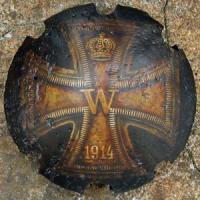
Uncategorised Help with photo
Spasm replied to dante's topic in Germany: Third Reich: Research, Documentation & Photographs
Ah, his taxi cab number -

Heer Help with Soldbuch findings
Spasm replied to Spasm's topic in Germany: Third Reich: Research, Documentation & Photographs
Hucks Did you do any investigation work on it? If so can I have it? I'd really like to try to get some more history on this guy. I'd like to put a bit of a display together with his medals (obviously not his actual ones), photo, bayonet, etc etc. Any advice would be good Spaz -

Heer Help with Soldbuch findings
Spasm replied to Spasm's topic in Germany: Third Reich: Research, Documentation & Photographs
Naxos Phew, thanks for that. First one of these I've owned so got too involved with trying to translate everything in babelfish and the military abbreviations book I'd like to think Karl had the chance to sit with his grandchildren on his knee saying "..and there I was, surrounded." Thanks Spaz -

Heer Help with Soldbuch findings
Spasm replied to Spasm's topic in Germany: Third Reich: Research, Documentation & Photographs
And lastly the crossed out equipment all dated 11 May 1945 (I think) and with the word "gest" clearly seen against the Seitengewehr (Bayonet) entry and repeated on most of the other entries. Did Karl really die on the last day of the war? I've sort of become attached to him the last couple of days, I really rather he hadn't :(



